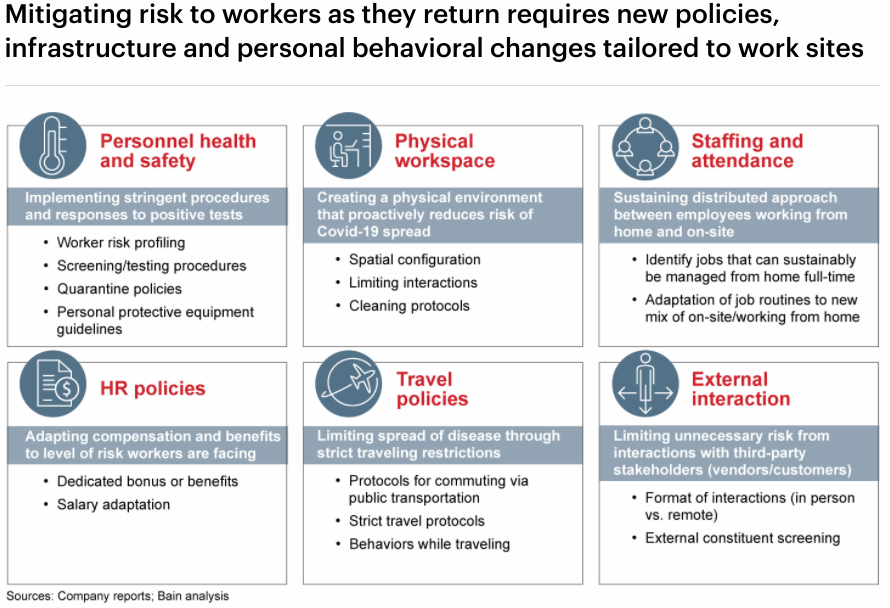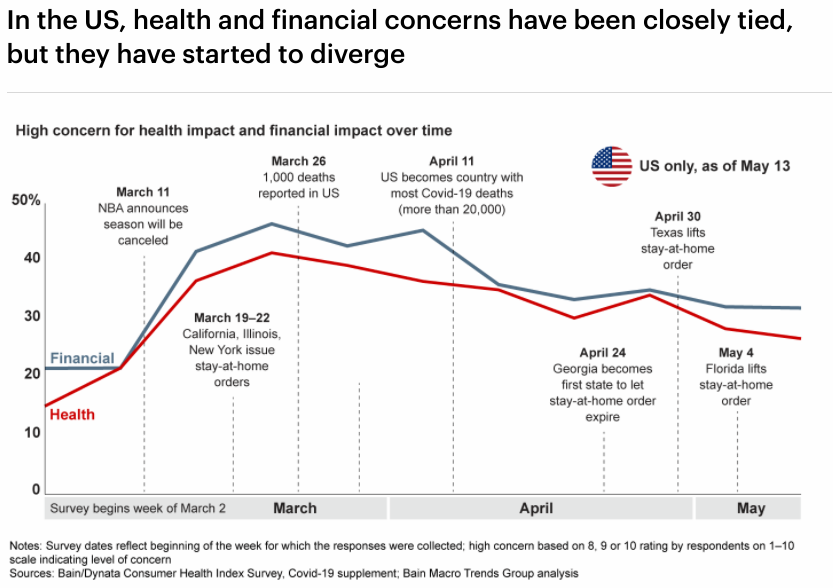How to adapt and retool your business as California starts to reopen from Covid-19 shutdown
Organizations that can thread the needle of both protecting and running the business today with retooling the business for tomorrow will outrun extinction and thrive after the pandemic. California is slowly starting to reopen according to recent reporting from the LA Times.
But the he actions that CEOs take now and in the weeks ahead will define them and their companies. And while the impact of this Covid-19 crisis varies across different cities and industries, it’s no joking matter to recognize that this time around, the burden of destiny is absolutely serious.
And as executive’s are working tirelessly trying to balance a hand full of critical priorities each day. Some are starting to focus on a few questions:
- How can we ride out the crisis to emerge stronger than others in our industry?
- How can the organization learn through this experience to win in a new world?
And to find solutions that will help guide the correct decisions and actions that will answer those questions—through the plethora of competing demands, the sometimes chaotic conditions and the paramount importance of doing the right thing—some leadership teams have committed themselves to two guiding principles: act now to protect and run the business today, and plan now to retool the business for the future.
Beginning over two months in March most companies had already taken the most important first step of dealing with the crisis which was making sure their employees and customers were safe. Which also meant business operations shifted to halting travel, and in-person meetings, temporary closures of facilities and rigorous protocols to protect essential operational teams. Essentially the Covid-19 outbreak called for a reexamining of policies and practices on employee benefits, remote working and employee engagement. Some companies that had manufacturing capabilities starting pivoting within weeks to produce PPE mask equipment or make hand sanitizer for first responders and communities.
Non essential consumer-facing companies most obviously got affected the hardest by the Coronavirus. Many management teams started with cash flow scenarios into proposed revenue declines from the shutdowns and stress tested the P&L and balance sheet. Some organizations companies are reallocating resources to pockets of current and future growth, such as e-commerce or digitizing their operations and processes, to protect against revenue loss.
Slowly getting back to work
Recoveries have always been a thing in business. Some of the biggest shifts in market share occur coming out of financial downturn cycles (recessions), when new industry leaders—and new industries—can emerge. But we are used health pandemics as the cause of one in this country.
According to a recent Bain & company article titled “getting back to work”, the post–Covid-19 world will accelerate some existing trends and create new ones, and all business models will have to evolve in order to grow and thrive. But they warn that could be a mistake to rely on forecasts for predicting the rest of this year. For most kinds of businesses, the recovery will mean restarting—in some cases, reinventing—operations in an unstable world of shifting conditions.
By putting in place the right mitigation and safety protocols and support to protect their employees, of which many are eager to get back to work, but worried about the risk of getting sick. The reopening of counties in California and slow return to work will also set the stage for retooling the business for a different future we are all living in. But this recovery won’t follow a straight line, so smart companies will need to be agile in their approaches. Questions are coming up such as:
- How should they track demand as it ebbs and flows to quickly serve customers when and where they show up?
- Are there sound actions to stimulate demand?
The businesses that can protect their people and build the most experience with real agility will create a competitive advantage and accelerate faster out of the downturn. In the US, the health concerns of covid-19 have been almost on par with the economic concerns that shutting down the country will have.
Reopening and getting back to work: A question of demand and supply
Employees willing to work are a critical component of the recovery, but companies can’t just turn the lights back on and hand out masks at the door to a returning workforce. For most executives, the task at hand is less like restarting a business than like starting a business. The Bain article states that “they face some of the same questions that confront every business founder: What are the customer needs that I can serve? Where is the demand, and how will we configure the business systems—supply chains, production and service operations, distribution—to meet it?” Only by first understanding the demand side of the equation can CEOs estimate their workforce needs and the urgency of returning different groups of workers to their jobs and work sites. This starts with evaluating customer demand by product or service and geography, and assessing the abilities of suppliers and distributors to support that demand.
How has Covid-19 affected direct customers’ demand? How are shifts in end-market demand affecting them? Are there ways to stimulate demand? How has Covid-19 affected the supply chain, and how will that constrain production and logistics? These questions will help leaders to forecast how many people need to return to work physically to meet that demand. In recent weeks, every business has either been temporarily shutdown or has learned new ways of working. Such as what work can continue be done working remotely from home, can be done more efficiently or can even be automated. And every company has discovered, through the crucible of the Coronavirus, that some work may not be necessary going forward in this post Coronavirus-world. But as retail stores and restaurants are facing stark new measures of reopening, limited capability, wearing masks, curbside pickup, social distancing, etc will have an impact on number of employees returning to work. Meaning companies must begin to return employees to work in phases, aiming to increase their numbers over time, but equally ready to shrink them—perhaps drastically—if another outbreak was to occur. Lets hope not. With the virus still active and an effective vaccine still many months away at best, new outbreaks are still a risk and cause for concern.
With the crisis breaking apart business systems, The Bain article suggests that setting up Agile teams could be an effective and scalable way to adjust and build resiliency into fluid operational environments. Local management teams, guided by nonnegotiable safety requirements, will learn and respond to conditions on the ground, continuously adapting, putting solutions in place and reporting successes to leaders who can scale them across the business. For smaller businesses—with a single product in a single region—adding back operations may be a delicate dance. But the greater a company’s geographic and product diversity, the more operations will fluctuate.
What is the workforce you need right now?
Tracking real product or services demand provides companies with a rational way to determine how many people need to return to work and where. But understanding the workforce they need—and who needs to return to a work site—is just the beginning of the recovery challenge. The top question every company faces is how to keep those employees safe in a constantly changing environment and how to mitigate the risks they face if they return to work. This assumes, not incidentally, that they can get there. Even if stay-at-home orders are lifted, workers may face childcare issues now that we entering into the summer months.
Also companies have little ability to mitigate virus risk in the community where their workers live. Cities aren’t likely to able progress continuously toward an absolute recovery of declining cases just yet, especially if social distancing and face mask protocols are not followed.
What does this all look like on the ground? For companies, returning employees physically to work means identifying and mitigating workplace risk. And they must do so in ways that build trust among employees.
Bain suggests that whether employees work in a store, an office, a factory, a warehouse, out in the field or at your customers’ homes, five factors determine how the virus spreads, and how to prevent it.
- Proximity: How physically close are workers to each other?
- Nature of contact: Do workers touch common items, other workers or customers?
- Duration: How long does a typical interaction last?
- Number of different contacts: How many interactions occur in a day?
- Ability to screen and remove: Are there screening points or protocols that protect your workers (and customers) from contact with contagious people?
Obviously the amount of risk these factors pose will vary widely. The good news is that mitigation policies, new infrastructure and individual behavior changes can dramatically reduce that risk, even in the environments that currently pose the greatest danger of transmission.

A retail store cashier may have hundreds of different contacts with customers throughout a day and touch thousands of items that customers have touched. By contrast, a factory worker on a line may handle many components and surfaces but have very few, if any, physical interactions with coworkers. Offices can dramatically reduce social contact by continuing work-from-home policies for all but essential personnel, but even these seemingly more controlled environments have pockets of high risk that must be addressed—elevators, for example, have quickly emerged as major chokepoints for office buildings. Every company will have to assess the risk profiles of their individual workplaces, but here are 10 of the most relevant categories:
- Customer-facing businesses (retail, restaurants)
- Manufacturing plants
- Warehouses and distribution centers
- Offices
- Call centers
- Field forces
- Education
- Personal care
- Agriculture
- Transportation
Mitigating individual worker risk
Over the past month in the US, worker comfort with the idea of returning to work has risen across most types of workplaces, and a substantial majority of American workers say they would return to work tomorrow if required by their employer and if safety measures are in place, according to the the Bain/Dynata American Workers Survey. With the exception of testing, which remains elusive, they also indicate that many companies have already adopted the safety measures they view as most important, including personal protective equipment, physical distancing and disinfectant sprays and wipes. Short of widespread testing or an effective vaccine, US workers rate effective safety measures higher than various government actions in terms of making them comfortable at work.
Leading the movement back to work
Ultimately, though, returning to work is a moment of truth for leaders and will be defined by trust. For employees, trust starts with both being safe and feeling safe—perception will be important along with the mitigation of real risks. In workplaces that include customers, this will be equally true for them.
Trust is also essential for returning to work. Make no mistake: The safety of workers and the future of the business requires that some rules be strictly enforced from the top down, with no exceptions, for the foreseeable future.
But as soon as it’s practical, leaders can empower their front-line managers to deal with local issues as they arise. This requires that workers get the training and psychological support they need to embrace, maintain and self-enforce safe behavior at all times. And companies can reinforce that trust and build agility by developing feedback loops to quickly deliver best practices developed on the front lines in one workplace to the rest of the organization. These feedback loops also demonstrate to employees that they are heard and play a critical role in reducing risk for their fellow workers.
Conclusion
Going back to work is necessary for recovery, and also moves the company closer to retooling for a new normal. With the future in mind, returning to work does not mean returning to the old ways of doing things. How can leadership teams build on experience to bring back a stronger, more focused, more resilient company? How can they win in the new world? Most companies won’t fundamentally change direction as a result of Covid-19, but the crisis has dramatically accelerated the speed at which they are traveling and how they navigate the journey. That may be the definition of a silver lining. And if we look at all the businesses that were deemed “essential” and allowed to stay open during this time, you can see the dramatic changes in safety and procedures they were making almost on a weekly basis, The Home Depots, CVSs, Safeways, Liquor stores etc. Which can sort be a play book or model for the rest of companies looking to doing business again.










